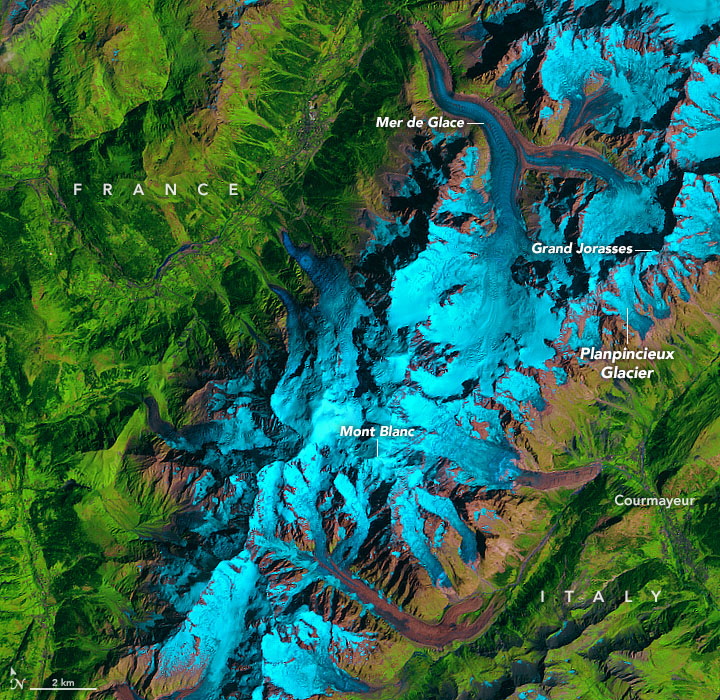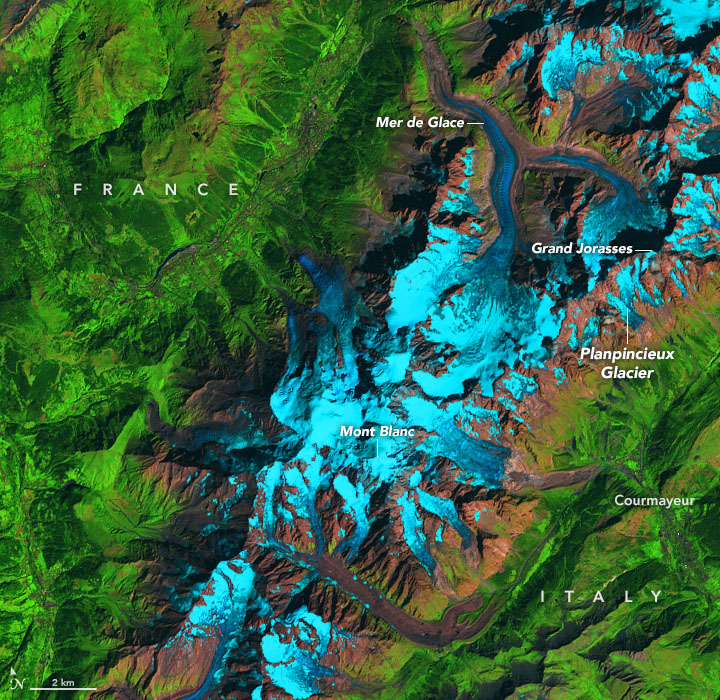

Ice Could Crumble from Planpincieux Glacier
Downloads
- mtblanc_tm5_1985230_lrg.jpg (2458x2000, JPEG)
- mtblanc_oli_2019237_lrg.jpg (2458x2000, JPEG)
Metadata
- Sensor(s):
- Landsat 5 - TM
- Landsat 8 - OLI
- Data Date: August 18, 1985 - August 25, 2019
- Visualization Date: October 1, 2019
A fast-changing glacier is threatening a popular hiking area in Europe’s western Alps. Experts have reported that a 250,000-cubic-meter chunk of ice is poised to break away from Planpincieux Glacier, which clings to a steep slope on Grand Jorasses peak in the Mont Blanc massif.
The false-color images above, acquired by Landsat satellites, show more than 30 years of changes to a portion of the Mont Blanc massif, including Planpincieux Glacier. The first (left) image was acquired by Landsat 5 on August 18, 1985; the second image shows the same area as observed by Landsat 8 on August 25, 2019. This glacier, along with others across the Mont Blanc massif, has been losing ice as air temperatures have steadily risen over Europe.
Planpincieux Glacier tends to lose ice from its front in large blocks. That’s because it is a “hanging glacier,” with its front perched on a steep slope. As the ice slides toward the ravine’s edge, fragments can break away and tumble into the valley below. Following the extremely warm summer of 2019, the glacier’s front was moving as much as 50 centimeters (20 inches) per day by late September.
Scientists cannot say with certainty when the collapse will occur. As a precaution, Italian officials have closed a road leading to Val Ferret, a valley near the town of Courmayeur. The area is a popular hiking and tourist destination.
The melting is not limited to Planpincieux; other glaciers across the Alps have been shrinking and thinning in recent decades. Research published in 2014 reported losses across the Mont Blanc area between 2003 and 2012, and the downward trend has continued through 2018. According to one computer model, the Argentière and Mer de Glace glaciers—the largest in the French Alps—could disappear or be significantly reduced by the end of the 21st century.
References
- The Associated Press, via The Public’s Radio (2019, September 30) Small piece of melting Italian glacier accelerates. Accessed September 30, 2019.
- Berthier, E. et al. (2014) Glacier topography and elevation changes derived from Pléiades sub-meter stereo images. The Cryosphere, 8 (2014), 2275–2291.
- Christian, V. et al. (2019) Déclin des deux plus grands glaciers des Alpes françaises au cours du XXIe siècle : Argentière et Mer de Glace. Association Météo et Climat.
- Forbes (2019, September 25) Melting Glacier Closes Roads After Record Summer Heat. Accessed September 30, 2019.
- Istituto di Ricerca per la Protezione Idrogeologica (2019) We monitor the Planpincieux Glacier, along the Italian side of the Grandes Jorasses, Aosta Valley. Accessed September 30, 2019.
NASA Earth Observatory images by Joshua Stevens, using Landsat data from the U.S. Geological Survey. Story by Kathryn Hansen, with image interpretation by Christopher Shuman (NASA/UMBC).
This image record originally appeared on the Earth Observatory. Click here to view the full, original record.